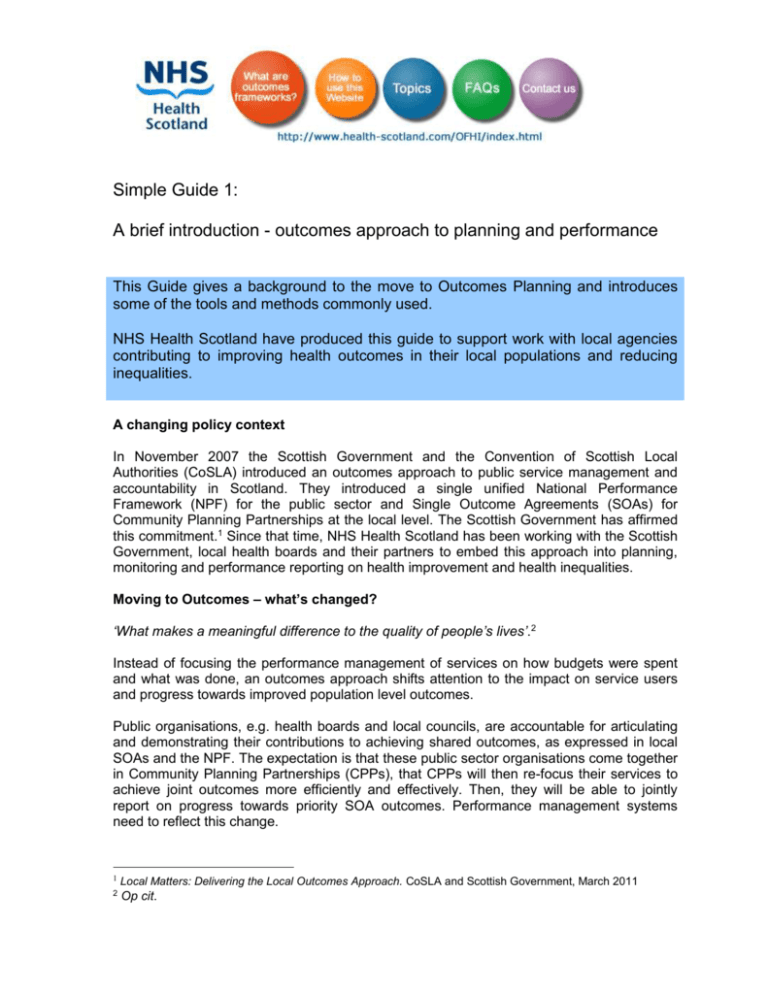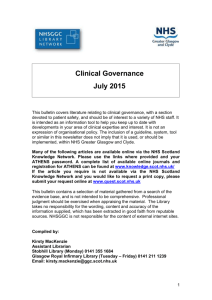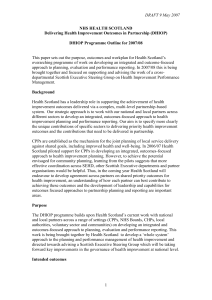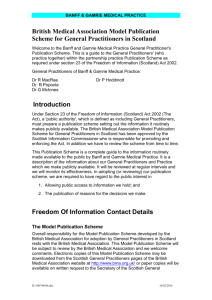Simple Guide 1
advertisement

Simple Guide 1: A brief introduction - outcomes approach to planning and performance This Guide gives a background to the move to Outcomes Planning and introduces some of the tools and methods commonly used. NHS Health Scotland have produced this guide to support work with local agencies contributing to improving health outcomes in their local populations and reducing inequalities. A changing policy context In November 2007 the Scottish Government and the Convention of Scottish Local Authorities (CoSLA) introduced an outcomes approach to public service management and accountability in Scotland. They introduced a single unified National Performance Framework (NPF) for the public sector and Single Outcome Agreements (SOAs) for Community Planning Partnerships at the local level. The Scottish Government has affirmed this commitment.1 Since that time, NHS Health Scotland has been working with the Scottish Government, local health boards and their partners to embed this approach into planning, monitoring and performance reporting on health improvement and health inequalities. Moving to Outcomes – what’s changed? ‘What makes a meaningful difference to the quality of people’s lives’.2 Instead of focusing the performance management of services on how budgets were spent and what was done, an outcomes approach shifts attention to the impact on service users and progress towards improved population level outcomes. Public organisations, e.g. health boards and local councils, are accountable for articulating and demonstrating their contributions to achieving shared outcomes, as expressed in local SOAs and the NPF. The expectation is that these public sector organisations come together in Community Planning Partnerships (CPPs), that CPPs will then re-focus their services to achieve joint outcomes more efficiently and effectively. Then, they will be able to jointly report on progress towards priority SOA outcomes. Performance management systems need to reflect this change. 1 Local Matters: Delivering the Local Outcomes Approach. CoSLA and Scottish Government, March 2011 2 Op cit. What can we learn from other countries? Many other countries have experience in implementing ‘Results-Based Management’ and ‘Outcomes-Based Accountability’. Many of the methods and tools we introduce here have been developed in other countries and we have adapted these for the Scottish context. We can learn from their experience that successful implementation is likely to be slow and ‘a long journey’. To be successful, reform is needed across a range of levels including: leadership for collaborative outcomes, shifting the focus of management to external results, developing wide ownership for outcomes frameworks, developing user-friendly, shared information measures/indicators and building in a regular review process. systems and sensible NHS Health Scotland’s work aims to support these reforms. Collaborating for shared priority outcomes For public services working to improve Scotland’s health, their contributions are primarily towards three national outcomes: 1. Our children have the best start in life and are ready to succeed. 2. We live longer, healthier lives. 3. We have tackled the significant inequalities in Scottish society. Strategies to improve outcomes in these three areas necessarily involve collaborative, cross-sectoral actions. The NHS is an important contributor to these partnerships but may not always be the lead agency. An important task for us has been to clarify what are the most effective contributions of different sectors and organisations towards achieving priority health outcomes using existing evidence to map out plausible pathways towards these outcomes. The tools we have used to do this are outlined below. The basic building block – the Results Chain The basic building block we have used to map out visually the intended pathways to improved outcomes is the ‘results chain’ (see Figure 1). This is a linear causal chain that runs from inputs to outputs to external outcomes. Figure 1: Basic results chain Typically the outcomes are time sequenced: Long-term outcomes are the ultimate health outcomes we want to achieve, such as reductions in CHD-related deaths Intermediate (or medium-term) outcomes are the changes in behaviours and the environmental factors that shape the intended health outcomes, such as reduced smoking prevalence or creation of environments that better promote physical activity Short-term outcomes are the more immediate effects of service delivery that we anticipate will contribute to changes in behaviours and improved environments. These might include giving up smoking after taking part in a smoking cessation programme, increased knowledge of a health problem and ways of addressing it or reactions to a programme, such as increased awareness or participation that might help or hinder achievement of the longer term outcomes. The results chains specify ‘reach’ i.e. the target populations for whom we are trying to achieve better outcomes. Target populations include the ultimate beneficiaries. They may also include intermediaries who can be important in accessing or engaging these beneficiaries. The results chains also specify the activities, services or other interventions by which these outcomes will be achieved and the partners involved in their delivery. There are a number of different resources we use to develop results chains but they share a common purpose, which is to clarify: the outcomes we are aiming to achieve how we will achieve them who will do what to achieve them steps on the way against which to measure progress. These resources are discussed below. Mapping the multiple pathways to outcomes - Outcomes frameworks In a number of topic areas (alcohol, tobacco, mental health) we have developed tools which bring together and summarise the existing evidence and map out the pathways between activities and intended outcomes. These resources, which build on the results chain, described above, are referred to as ‘outcome frameworks’ and contain three components: an outcomes triangle, logic models and multiple results chains: 1. The ‘outcomes triangle’ format was devised to align with the 2007 Scottish Government visuals. It is intended to communicate some of the main areas in which actions will be required to achieve agreed outcomes. 2. Logic models combine a diagram and text to illustrate the relationships among elements of a programme and the outcomes to be achieved. Logic models help in planning programmes and in defining how to measure the success of the programme. 3. The multiple results chain shows a much simplified picture of the most important contributions of a series of partners to common shared outcomes. Both logic models and multiple results chains have been found useful to communicate the central idea that many of the improved health outcomes we ultimately hope to achieve will require: input from a range of agencies a sequence of changes over time a joint performance management approach and a joint monitoring and evaluation strategy to track whether these changes are being realized in the ways intended. Both the end product (logic model/results chain) and the shared process of developing these tools are important aspects of programme and evaluation development. The outcome frameworks are intended to be used in three main ways: as an organising framework for evidence summaries accessible via the web as a model to inform strategic partnership planning that can be used or amended to fit local needs; the feasibility of using and applying the outcome frameworks in this way is currently being tested as the basis for monitoring and evaluation. Performance Reports Performance Reports provide a narrative version of the Results Chain. They can be used to ‘tell the story’ of an organisation’s contribution to shared outcomes in the last year (or some other specified time period). They can also be used at the beginning of a programme to map out what will be delivered and to clarify data and knowledge needed to inform understanding of progress. These reports use monitoring and evaluation data to provide an accessible account of the reach and results of a project or programme, what was learned in the process and any consequent adaptations/improvements that have been or will be made as a result. They are flexible in terms of how they are presented. Typical headings used in a Performance Report are: Headline - A succinct and eye-catching statement about the programme’s main achievement in the last year and its contribution to national outcomes Rationale - A brief statement about the problem being addressed and whose needs the programme prioritises. Resources Used – Indicates the size/scale of the programme by its total expenditure in the last year and staffing levels Activities/outputs - A brief statement about what has been delivered in the past year Reactions – these are important because they can facilitate or hinder progress and provide useful insights into the likelihood that a programme will be successful. Reach & Results – A summary of whom the programme has reached with its services/outputs and the outcomes achieved. Contextual and external factors - that were beyond your direct control that prevented, delayed or otherwise affected your results and how these were addressed, including unintended consequences and secondary effects. Implications and Learning – A summary of what worked well/as expected, what didn’t and why, and what adjustments were/will be made to the Programme next year to improve performance. It may also include learning to share in-house about the way you do business in the future in relation to programme delivery and/or partnership working. NHS Health Scotland is developing the use of performance reports for internal performance reporting and they have been used to inform other programmes in Scotland. Contacts and Further Information http://www.healthscotland.com/OFHI/. If you want to speak to someone about the NHS Health Scotland’s work on implementing an outcomes approach, contact Jane Ford at jane.ford3@nhs.net.











